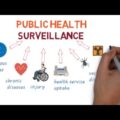DEFINITION OF EPIDEMIOLOGY
The World Health Organization (WHO) defines epidemiology as a branch of medicine that relates to the study of the incidence, distribution, and possible control of disease or determinants of health. One of the most important issues in any community is health and its determinants. This is because the socioeconomic development of any community is largely dependent on the health status of its population.
CONCEPT AND THEORIES IN EPIDEMIOLOGY
DISEASE AND HEALTH
Disease refers to any interruption or deviation from the normal function and or structure of the body which is characterized by specific signs and symptoms.
Health according to the WHO, is not just the absence of disease but also a state of optimum physical, mental, and social well–being.
Understanding these two concepts is very critical as it will help in providing a better definition of disease and health in health bulletins, public enlightenment campaigns, and other health information and communication materials.
EPIDEMIOLOGICAL TRIAD
This is an illustration that shows how infectious diseases thrive. It depicts the interrelationship between the agent, host, and environment. This is also called the chain of infection.
The application of this concept is important in the training community of health workers on the aetiology of infectious diseases. Their improved understanding of the interaction of agent, host, and environment as depicted in the epidemiological triad will advance health education and reduce prevalence rates of infectious disease in communities.
CONCEPT OF CLINICAL EPIDEMIOLOGY
This is the science of making predictions about individual patients by counting clinical events in similar patients, using strong scientific methods for studies of groups of patients to ensure that the predictions are accurate.
Clinical epidemiology is the foundation on which modern medicine is practiced. It is used as an aid in clinical decision-making and leads to valid conclusions by avoiding being misled by systematic error (bias) and chance.
EVIDENCE PYRAMID
This is a diagram that was created to help us understand how to weigh different levels of evidence in order to make health-related decisions. It provides an overview of each study by bringing the relative strengths and weaknesses of each design into perspective.
The adoption of the evidence pyramid helps clinicians put the results of each study design into perspective. When applied it also reduces the chance of statistical error and provides a guide for the physician to make clinical decisions based on the highest quality of evidence available.
CONCEPT OF CO-FOUNDER
Confounding occurs when a factor other than the one you are studying is associated both with the disease and the factor you are studying. This can make it seem as though the factor you are studying causes the disease even if, in reality, it does not. Confounding distorts the true relationship between exposure and disease and should be controlled.
In carrying out epidemiological studies, the understanding of this concept is imperative so as not to end up with a distorted result that presents a wrong picture of the true relationship between exposure and disease. Therefore a clear understanding of this concept and the various ways to exclude or control confounding variables including randomization, Restriction, and Matching will ensure the result of a study is valid.
CONCEPT OF SYSTEMATIC REVIEW
Systematic review identifies and appraises empirical evidence based on pre-specified criteria. It is a type of literature review that analyzes multiple research. It comprehensively locates, evaluates, and synthesizes all the available literature on a given topic using a strict scientific design which must itself be reported in the review. Systematic reviews are not limited to medicine.
CONCEPT OF ICEBERG PHENOMENON
This refers to the recognition of gross conditions and diseases, and the failure to recognize the great majority of conditions that are mild and not clinically obvious.
As a physician, understanding this phenomenon can be the difference between life and death for patients, Uncovering diseases that might otherwise be below “sea-level” by screening and early detection often allows for better disease control.
CONCEPT OF MONITORING AND EVALUATION
Monitoring and evaluating progress are important functions in public health because it serves as a benchmark for performance rating. It shows whether a service/program is accomplishing its objectives or not.
The application of this concept in disease surveillance and response by the utilization of its tool will provide a clear overview of where progress is being made, the loopholes and gaps if any, and where improvements are needed especially in project management and field assessments.
CONCEPT OF TRANSLATIONAL RESEARCH
Translational research transforms currently available knowledge into useful measures for everyday clinical and public health practice. Translational research aims to assess the implementation of standards of care, understand the barriers to their implementation, and intervene throughout all levels of health care delivery and public health to improve quality of care and health outcomes, including quality of life.
This concept is applied by the systematic conversion of basic research knowledge into practical applications to enhance human health and well-being.
CONCEPT OF IMMUNITY
Immunity is the body’s ability to fight off harmful microorganisms PATHOGENS – that invade it. The term immunity is derived from the Latin word “immunis” which means to exempt.
APPLICATION OF CONCEPTS TO CLINICAL PRACTICE AND DISEASE SURVEILLANCE
- With a clear understanding of the concept of health and diseases, disease surveillance officers will be able to produce information and communication materials that define health and diseases with a broader perspective.
- The application of the concept of the epidemiological triad if incorporated into routine training programs for local health workers, will improve their understanding of infectious disease and the different factors (agent, host, and environment) at play.
- Clinical epidemiological procedures and practices if reinforced at local health facilities as an aid in clinical decision making, will help the health worker avoid being misled by systematic error (bias) and chance
- The adoption of the evidence pyramid will help clinicians and epidemiologists evaluate the relative strengths and weaknesses of each level of evidence and provide a guide for physicians to make clinical decisions based on the highest quality of evidence available.
- The improved understanding of the concept of co-founding will help improve the effectiveness, accuracy, and quality of field research work by eliminating or controlling confounding variables
- Systematic review when adopted will help teams to collect and critically analyzes multiple research studies, papers, clinical tests, public health interventions, environmental interventions, social interventions, and adverse effects.
- As a physician, understanding the tip of the iceberg phenomenon can be the difference between life and death for patients. Being conscious of the likelihood of the presence of unseen factors in patients being treated will lead to improved screening and detection for better disease control.
- Improving health and interventions projects which form the core of disease control mandate will not be possible without the effective adoption of monitoring and evaluation protocols.
- The application of the concept of translational research will enhance the systematic conversion of basic research knowledge into practical applications to enhance human health and well-being, especially for rural dwellers.
- At the core of HIV /AIDS intervention schemes is a holistic plan to improve nutrition and boost immunity. An improved understanding of the concept of immunity will also enhance the quality of health promotion materials especially tracts and posters.






